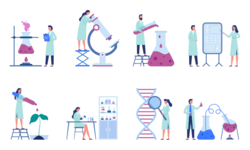ATD Blog
Getting the Best Out of Cacao Beans—and Human Beings
Wed Feb 14 2018

Bookmark
In my previous article, I used the process of making fine chocolate as a metaphor for developing great employees. Just as the best artisan chocolate bars leverage the unique flavors and traits of indigenous cacao beans, organizations can get the best out of people when they maximize their individual strengths and passions.
But how can you tell if people in your organizations are working with passion and leveraging their strengths?
Alaina Love is president of Purpose-Linked Consulting and co-author of The Purpose-Linked Organization: How Passionate Leaders Inspire Winning Teams and Great Results. She explains that passion shows up in noticeable ways. “It’s the sparkle in employees’ eyes on a Monday morning; the intensity of their excitement about a new project assignment; the pride that they take in the company’s achievements; or the long hours they’ll willingly devote to solving a problem, just because it intrigues them,” Love says.
How to Get Started
This begs the question: Where do I start? The short answer: with yourself. That may sound selfish, but you can’t pull people to higher ground if you’re not there yourself. After writing the bestselling book, 7 Habits of Highly Effective People, the Stephen R. Covey stressed the need for an eighth habit: find your voice and help others find theirs.
“Everyone has unique gifts, talents, and capabilities that are only slightly leveraged in most organizations,” Covey explained. “Finding your voice means bridging the painful gap between possessing great potential and actually living a life of greatness and contribution. Helping others to find their voices is the key to leadership success.”
Begin a Discussion
Once you’ve found your voice, or are at least on that path, get your people engaged in a discussion about their passions and strengths and how they relate to the needs of the organization. While there are many ways to approach this effort, I’m amazed at the results every time I observe the discussion that is a key part of our experiential learning activity, Chocolate: Passion at Work. Whether the participants are machine operators or executives, they are able to glean insights on how passion can enhance their jobs and improve their performance. In fact, the primary purpose for watching the short film about the journey of a passionate chocolatier and then savoring some chocolate bars is to set the stage for an engaging, impactful discussion.
One reason these discussions are so productive is that eating chocolate actually releases endorphins that reduce feelings of stress and improve one’s mood. Plus, chocolate is inherently appealing; 90 percent of people love chocolate and 50 percent say they can’t live without it. No wonder chocolate is an effective way to start off a discussion. You’d be wise to begin whatever discussion you have with a little chocolate.
Some questions that might trigger an animated discussion include:
Do I have the opportunity to do what I do best every day? (About 59 percent of employees typically say no.)
How well do my current roles and responsibilities match up to my strengths and passions?
What do you think the company passionate about?
What could the organization do to inspire more passion at work?
What should the company stop doing that discourages passion at work?
Do you have the tools to do your work well?
Help Employees Discover Their Passions and Strengths
Just as an artisan chocolate maker skillfully uses a roaster to coax distinctive flavors out of cacao beans, leaders have insightful tools available to help people gain a better understanding of their passions and strengths. Two of the best are Purpose Linked Consulting’s Passion Profiler and StrengthsFinder 2.0 from Gallup.
The Passion Profiler is an online assessment tool that scientifically measures an individual’s expression of purpose as work-related passions. These quantifiable passions are expressed as a person’s top three (out of 10) primary archetypes, which define his or her overall approach to work and life and provide insight into how an individual can be motivated to deliver their very best.
StrengthFinder 2.0 also is an online assessment that measures a person’s unique strengths from among 34 primary talent themes and over 5,000 related strength insights. You also will want to check out the New York Times bestseller StrengthFinder 2.0 by Tom Rath.
Once people know their passions and strengths, what’s next? Organizations can get some advice from Alaina Love and Halelly Azulay of TalentGrow, author of Strength to Strength: How Working From Your Strengths Can Help You Lead a More Fulfilling Life.
Hire people based on their passions and strengths. Love recommends asking a few key questions in job interviews:
What are you most passionate about and why?
How do you envision applying those passions in this job?
How are you applying those passions now?
Assign work roles based on passions and strengths. If you don’t have a lot of flexibility in work roles, offer special assignments that will provide an outlet for your employee’s passions. See that your team is balanced and that a wide variety of relevant passions and strengths is represented. “There are many ways to slice work to be done,” reminds Azulay. “So instead of limiting yourself to a one-size-fits-all, cookie-cutter approach, why not strive to get diverse strengths represented on your team in a way that all the work gets done but as much of it as possible is done by people who actually were born to do it, rather than loathe or merely tolerate it?”
Have a conversation about strengths and passions. As part of your regular performance reviews, have a conversation with your employees about their strengths and passions. Azulay suggests managers use the information gleaned in these discussions to design jobs that “capitalize on, leverage, and maximize \[their strengths\] as much as possible.” She advises organizations to “craft jobs in ways that get the best output from each person toward the end-game of the team, department, and organization.”
Provide training to help people achieve their potential. Most L&D efforts seem to focus on skills training. However, Alaina Love asks whether it makes better sense to align training with individual passions whenever possible? “Passion is what makes learning stick, so the organization receives the greatest ROI when passion is factored into employee development decisions,” says Love. “While employees’ skills will always be important to successfully achieve goals, their passions will define the difference between marginal success and flourishing, both for the organization and the individual.”
Communicate clearly the organization’s mission and purpose. Help each employee understand how his or her role contributes to the company’s success in reaching its key goals. According to Love, “A company with a well-defined purpose and passionate employees who share it can unleash a megawatt boost of employee enthusiasm that can only be born when purpose and passion align.”
Last Word
According to Azulay, “When employees are able to maximize their strengths at work, they are more likely to contribute to their full potential, feel more satisfied and engaged, and produce higher quality results. Therefore, leaders should engage employees in conversations about their strengths: what are they, do they get to use them daily, and how to leverage them more. It’s a win-win proposition!”
With that closing thought, be sure to use these ideas on how to use strengths and passion to get the best out of the people in your organization. Remember: Companies that harness the collective strengths and passions of their employees gain significant HR, operational, and strategic advantages.
More from ATD





